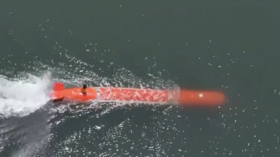Feds covering security flaws with Fukushima-like potential, nuclear whistleblowers claim

Two nuclear power whistleblowers have publicly accused the Nuclear Regulatory Commission of taking steps to cover up dangerous shortcomings at American power plants, including severe flood risks facing nuclear power plants downstream from large dams.
Richard H. Perkins and Larry Criscione both have a government and military experience and recently worked at the NRC, which was created to oversee reactor safety and security. Compromising their jobs for the sake of speaking out, the men have publicized the severity of the flood risks facing a number of nuclear power plants using a number of documents obtained by the Huffington Post.“When you’re working with sensitive information, you just don’t talk about it, so what I’m doing I find to be both perverse and uncomfortable,” Perkins told the Huffington Post. “But I had to do it."After realizing that some details regarding the dangerous flood threat were withheld for years at the expense of public security, Perkins and Criscione felt the need to tell someone.If a nuclear power plant floods past the level the facility is built to withstand, power to the plant from a grid connection or back-up diesel generator could be lost, causing an inability to circulate water to keep the reactor core or the spent fuel pool cool. If the plant cannot be kept cool, a catastrophic disaster similar to the failure at Japan’s Fukushima Daiichi plant could occur.“If we believe there is a security vulnerability, we need to take measures to address it and not merely withhold it from public discussion,” Criscione said.When Perkins in 2010 was assigned to review the dam-flood threat at nuclear power plants across the US, the NRC censored his analysis to exclude certain information. When an edited version of the report was completed and shared among NRC employees in June, 2011, large parts of the document were blacked out.NRC officials claim they sometimes withhold information to promote safety – to keep the information from falling into the hands of terrorists, for example.“But the redactions by the NRC did not promote safety in any of these ways. The actions have, in fact, allowed a very dangerous scenario to continue unaddressed for years,” Perkins said.Nuclear power plants are required by US law to be able to withstand all types of weather conditions that could occur in the region they are located. But many of the flood walls built to protect the plants are inadequate. The Oconee Nuclear Station in South Carolina is protected by a 5-foot wall, but the plant is located near a dam that could result in floodwaters as high as 16.8 feet and cause a meltdown similar to Fukushima.These flaws, which reports indicate were found at plants across the country by latest 2005, were kept secret while NRC staff prepared an internal communications plan to deal with potential questions that could be asked about the power plants’ vulnerabilities. The Oconee Nuclear Station, owned by Duke Energy, was never shut down or properly assessed, even though it had a high risk of failure.The NRC refused to acknowledge that there was any sort of risk involved in keeping the plant open, promting Perkins to speak out in September and submit a letter to the NRC’s Officer of the Inspector General, charging that the NRC was involved in a cover-up, the Huffington Post reports.“The Nuclear Regulatory Commission staff may be motivated to prevent the disclosure of this safety information to the public because it will embarrass the agency,” he wrote. “The redacted information includes discussion of, and excerpts from, NRS official agency records that show the NRC has been in possession of relevant, notable and derogatory safety information for an extended period but failed to properly act on it. Concurrently, the NRC concealed the information from the public.”Criscione publicized his concerns partially due to a personal experience he had with a flooded dam. When the Tom Sauk hydroelectric reservoir broke and released 1 billion gallons of water to destroy part of a forest and a camp site that Criscione frequently visited, he realized the risks involved with many of the nuclear power plants located near dams.After hearing about Perkins’ report, Criscione decided to follow in his path and sent a letter to NRC Chairwoman Allison MacFarlane, attaching dozens of letters between the NRC and Duke Energy.But even after the letters were sent, the NRC told the Huffington Post that the Oconee plant was facing no risks and that “Duke has taken appropriate actions to ensure Oconee can safety mitigate flooding events.”Still, Perkins and Criscione stand by their beliefs that many US power plants are in danger. Criscione suspects there are many other engineers who may also feel compelled to speak out, but are afraid of losing their jobs.“We don’t work for nuclear operators, after all. We work for the American people,” Perkins said.“It’s the two of us against the entire federal government,” Criscione added.















